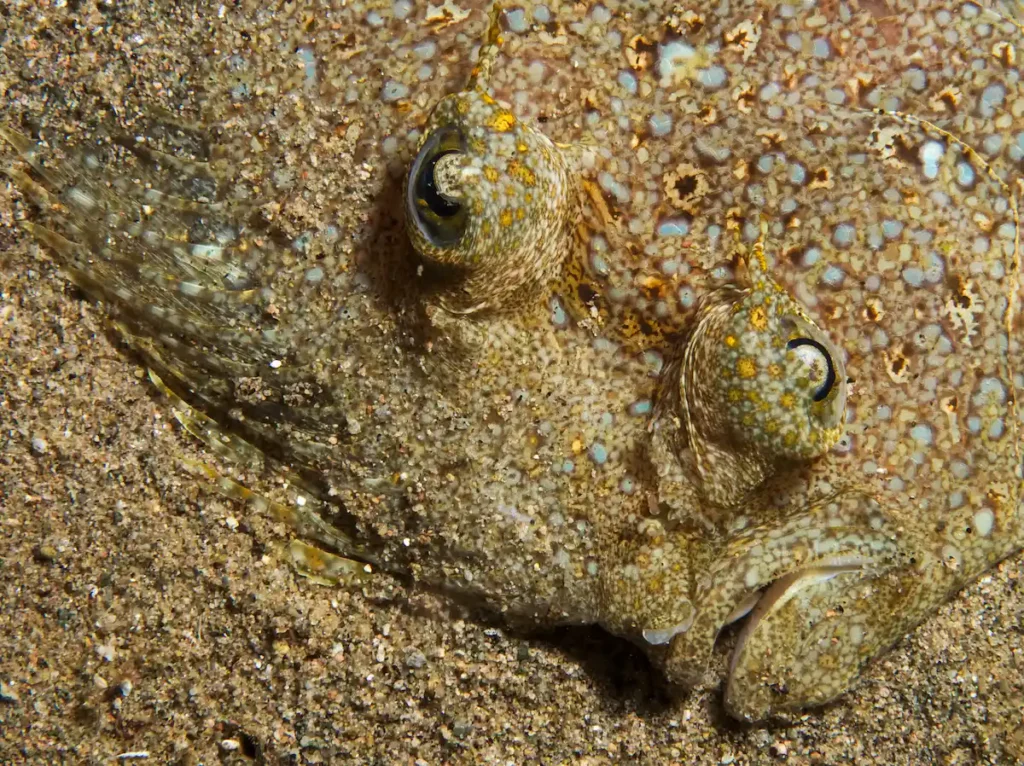If you’re reading this, odds are you’ve already heard of flounder. Maybe you’ve even eaten it or seen it in the wild! But how much do you really know about this flatfish? Read on to learn fun facts about flounder.
1. They’re flat.
Okay, this one might not be considered a fun fact in itself because all you need to do is look at a flounder to know this is true. But since it’s one of the flounder’s most distinctive features, it’s worth talking about!
Flounder are flatfish, meaning they have a flattened body shape that allows them to blend in with the seafloor. Unlike many other fish, both of the flounder’s eyes are on the same side of its body, pointing upwards to the sky. This makes sense, as a normal eye-on-each-side-of-the-head structure would mean one eye is perpetually buried in the sand.
See more wonderful ocean animals!
Enter your email and never miss an update
<!– –>
Flounder don’t start out flat, however: baby flounder look like any old larval fish, with two eyes on either side of its noggin. As they grow, their body changes. Eventually, more muscles and tissue begin to form on the underside of one eye, pushing it closer to its mate. By the end, both are firmly planted on one side of the head. (Whether it’s the left or right eye that moves depends on the species!)
2. They’re not the only flatfish.
We know that flounder are considered flatfish, but they’re not the only ones in this exclusive group! There are more than 600 species of flatfish, all within the order Pleuronectiformes. They’re known for their flat, oval-shaped bodies with both eyes on one side of their heads. This body form is unique among fish because it’s asymmetrical—take a moment and picture any other fish that comes to mind; aren’t they all the same on both sides of their bodies? Most fish are bilaterally symmetrical, meaning you could draw a line between their eyes and down their bodies and both halves would look the same—not so for flatfish.
Other famous flatfish include sole and halibut, two very popular seafood items. Pacific halibut (Hippoglossus stenolepis) can grow to more than eight feet long and five feet wide, giving them the nickname “barn doors.” The largest one ever recorded was caught off Alaska and was almost 460 pounds!
3. They have great camouflage.
Changing color can really come in handy in the ocean—it can help marine dwellers both hide from predators and sneak up on prey. Flounder are masters of disguise, thanks to special cells called chromatophores that help them blend into their surroundings. These cells essentially change shape to allow more or less color based on signals from the brain and are the same cells used by octopuses. Generally, they are darker on the upper side of the body, which helps them blend in with the sea floor, and lighter on the underside, which helps them blend in with the sunlit surface when they swim upward to catch prey. Check out five other critters with top-notch camouflage.

4. There are lots of different types of flounder.
No matter where you live, odds are there is a flounder that is relatively close to you. In the Western Atlantic, summer flounder are found from Canada to Florida and are a popular commercial and recreational fishery. In the Gulf of Mexico, the aptly named gulf flounder can be found in rocky, sandy and seagrass bottoms. And in the Northern Pacific, the olive flounder is a delicious fish often served as hirame in sushi restaurants. Both large-toothed and sand flounder (the two common groups of flounder) are part of the Paralichthyidae family which contains over 100 species.
We know that multiple species of flounder are vulnerable to climate change, including summer and winter flounder—two very popular flounder species found on the East Coast of the United States. Winter flounder, in particular, are very sensitive to climate-driven changes—; for example, predators like comb jellies and sea robins are thriving in warmer waters, increasing predation pressure on juvenile winter flounder.
Here at Ocean Conservancy, we are dedicated to working with all levels of government to implement sustainable ocean-based climate solutions to protect flounder and other species. Learn more about our work and how you can take action for our ocean.
The post Fast Facts About Flounder appeared first on Ocean Conservancy.

